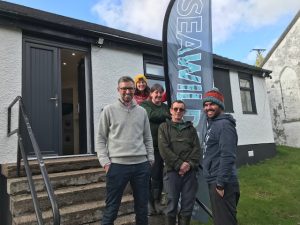Environmental consultancy MacArthur Green and its charity partner Seawilding have been awarded a £10,549 grant by the Scottish Marine Environmental Enhancement Fund (SMEEF) to investigate restoring native oysters to Loch Gair.
Glasgow-based MacArthur Green and Seawilding, based at Loch Craignish, successfully applied for the SMEEF funding to carry out detailed research into the current state of the oyster population in Loch Gair.
A well-attended information meeting and exhibition was held in Lochgair Village Hall on Saturday October 14 to inform the community about the project and the potential plans going forward.
The native oysters plan comes after MacArthur Green purchased land and foreshore at Lochgair in 2016.
A recent survey by Seawilding as part of the SMEEF grant found that apart from pockets of large live native oysters in the loch, the number of molluscs has dwindled over time due to unsustainable harvesting.
In addition to the survey, MacArthur Green and Seawilding will use the funds to engage further with the community with a view to laying the groundwork for the re-establishment of a thriving native oyster population in Lochgair, as part of their community-led marine habitat restoration.
MacArthur Green said oysters are important to the environment because they filter seawater, from which they get their food and nutrients.
This purifies the water by removing pollutants and chemicals.
One oyster alone can filter 200 litres of water a day. In addition to these benefits, oysters also sequester carbon and contribute to biodiversity by creating underwater reefs.

David MacArthur, who owns MacArthur Green with wife Kirsty, said: “Our desk-based research and survey work has shown that in the past Loch Gair and Kames Bay contained abundant native oyster and blue mussel populations, which were an important source of food and income for the local community.
“Now only a fraction remain in the loch. We want to join the growing marine habitat restoration movement by undertaking a restoration of the native oyster population in Loch Gair’s waters in partnership with Seawilding.”
This partnership project is the latest undertaking by MacArthur Green, which works with clients to deliver projects that are beneficial to the environment.
MacArthur Green follows a biodiversity positive, carbon conscious business model, which it is continuing at Lochgair to reduce its carbon footprint.
In 2019, David and Kirsty oversaw the planting of almost 30,000 trees at MacArthur Green’s woodland site at Lochgair.
Kirsty said: “A native woodland is nature’s way of removing CO2 from the atmosphere while also boosting the natural habitat for wildlife in the area.
“For us, it is a common sense approach to land management and the environment that our clients would value and support.
“We have also invested in three hybrid and electric vehicles, while all our employees travel by train for mainland UK meetings.”
Danny Renton of Seawilding said: “We are extremely grateful to SMEEF that it has awarded our partnership project with MacArthur Green £10,549 that will not only significantly benefit native oyster populations in Loch Gair but empower the area’s local citizens to invest their own time and energy into making sure this project is a success.”
Sarah Brown, fund manager for SMEEF at NatureScot, said: “We are delighted to be supporting MacArthur Green through the awarding of a £10,549 grant to establish whether a viable population of native oysters exists in Loch Gair, and what the potential might be for restoring this population.”
Oly Hemmings and Pete Creech of the Heart of Argyll wildlife organisation have helped MacArthur Green and Sea Wilding with environmental interpretation and community engagement.
On the October 14 public information event, David MacArthur added: “The project was well received by the local community so the next steps will be drawing up plans for the first step of the restoration project where we – MacArthur Green, Sea Wilding and the community – will place 10,000 young oysters in Loch Gair bay and monitor their survival and growth rate and environmental conditions.
“This will give us a better idea for the optimal locations in the loch which will then inform future years of introducing further young oysters to eventually get to a healthy self-sustaining population.
“It is a multi-year project and the vision is to have reinstated the oyster beds which are so important for water quality, marine biodiversity and carbon sequestration.”